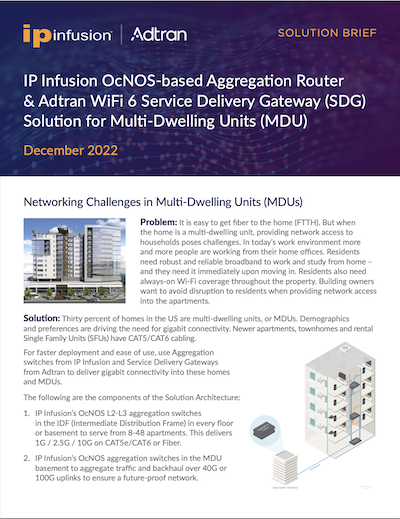
According to recent data from the Organisation for Economic Co-operation and Development (OECD), fiber-based solutions have become the primary broadband technology in most developed nations. In the 38 nations examined during the study, fiber optics accounted for over 160 million subscriptions, representing nearly one-third of all broadband subscriptions. Cable internet services ranked a close second, with just over 150 million subscriptions.
As broadband technology has evolved, these two top options have become far more affordable and accessible, but deploying these technologies continues to represent a significant pain point for service providers.
Replacing old cabling with fiber optic lines or modern broadband cables is costly and time-intensive. Even after new systems are in place, service providers must overcome yet another hurdle — creating a service delivery gateway that can handle the workload of the new system.
Providing fiber optic access to customers is particularly challenging when the resident is part of a Multi-Dwelling Unit (MDU). Still, service providers and property management companies must prioritize offering this service.
MDU residents no longer classify broadband connectivity as a “nice-to-have” amenity, seeing it instead as an essential commodity. According to a 2021 survey of MDU residents, 80% of respondents rated broadband internet above other amenities in terms of importance.
While it may be tempting for providers to focus on serving customers that occupy single-family dwellings, doing so would require them to overlook about one-third of their market share. According to Statista, 56.15 million residences in the United States are MDUs, representing about one-third of all dwellings in the country.
Fortunately, service providers and property managers can effectively deliver fiber optic broadband service to MDU residents without incurring exorbitant expenses by leveraging IP Infusion’s OcNOS broadband aggregation router.
How is IP Infusion Impacting the Broadband Aggregation Market?
IP Infusion is rapidly increasing its market share in broadband aggregation via its OcNOS-based broadband aggregation router. The OcNOS Aggregation Router interoperates well with other vendor products. For MDU use cases, IP Infusion’s OcNOS software interoperates well with Adtran’s WiFi 6 Service Delivery Gateway. These two products together facilitate the delivery of broadband services to dwellings throughout an MDU.
Why is IP Infusion Successful in Broadband Aggregation?
IP Infusion’s OcNOS-based broadband aggregation router addresses the three key pain points associated with delivering broadband services to MDU residents, which are as follows:
1. Alleviates Lengthy Deployment Timetables
When residents move into a new MDU, they expect to be provided with Internet services rather quickly. When MDUs provide these services through traditional methods, it is difficult for them to meet residents’ expectations.
IP Infusion’s technology works to streamline both the initial deployment and delivery of service. With IP Infusion’s OcNOS broadband aggregation router, service providers can deploy new networks quickly and efficiently, thereby improving the resident experience.
2. Reduces Use and Maintenance Complexities
Overly complex networks are not just tricky to install but challenging to maintain as well. The combination of IP Infusion’s OcNOS broadband aggregation router and Adtran’s SDGs provide unmatched ease of use and drastically simplify maintenance. This makes them both appealing to service providers and property management firms alike.
3. Reduces Costs
The biggest hurdle MDUs encounter when exploring broadband solutions for their residents is cost. Deploying broadband services to condominiums, apartments, and the like is incredibly costly through traditional strategies.
Fortunately, IP Infusion allows MDUs to drastically decrease deployment, installation, and upkeep costs, making a facility-wide systems upgrade feasible. MDUs can also pass some of these cost savings onto residents, making their rental property more appealing to prospective customers.
What Differentiates IP Infusions’ Broadband Aggregation Router?
IP Infusion’s broadband aggregation technology stands out from alternative solutions. Its most notable value proposition is its compatibility with products from various vendors.
While interoperability represents a considerable advantage in its own right, IP Infusion’s OcNOS broadband aggregation router provides several other benefits, including the following:
Migration Facilitation
The OcNOS software can facilitate an MDU’s migration away from legacy services to modern broadband solutions. IP Infusion and its broadband aggregation routers help make migration practical, timely, and cost-effective.
Hardware Independence
IP Infusion’s OcNOS software offers true hardware independence due to its superior interoperability with other vendors. With OcNOS software, property management firms and service providers can choose the auxiliary hardware that best aligns with their budget and needs, facilitating a shorter time-to-market and a faster roll-out of services.
Scalable System Architecture
The demand for affordable housing inevitably leads to constructing new MDU properties and expanding existing ones. The latter group will need to expand its various amenities to accommodate these additional housing units, including its broadband system.
Historically, expanding an internet service delivery system can be challenging, but IP Infusion designed its OcNOS broadband aggregation router and switches to facilitate scaling. In other words, these technologies make it easier for MDUs to expand their system architecture as the demand for such services grows.
IP Infusions’ Technology in Action: Adtran WiFi 6 Service Delivery Gateway for Multi-Dwelling Units (MDU).

IP Infusion’s solution architecture has been successfully deployed in several newly-built greenfield MDUs and existing brownfields. While the specific solution architecture of each deployment is unique to the facility in which it is installed, every deployment includes these components:
- OcNOS L2-L3 aggregation switches on every floor
- The Adtran 854-v6 SDG in every living unit
- OcNOS aggregation switches in the MDU basement
IP Infusion’s OcNOS broadband aggregation router interoperates seamlessly with Adtran’s WiFi 6 Service Delivery Gateway for Multi-Dwelling Units (MDUs). Cumulatively these technologies allow the solution to efficiently support triple-play services such as video, data, and voice applications. Read the MDU Solution Brief here.

Mani Subramanian is the Director of Marketing for IP Infusion.

